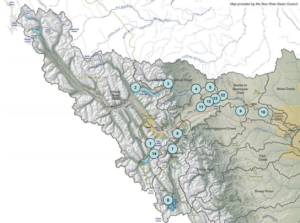With respect to the Bow River Water Management Options project, Alberta Environment and Parks (AEP) has spent the last six months focusing on site selection for three reservoir options on the Bow River upstream of Calgary.
As part of its commitment to engagement, AEP has provided community stakeholders with an update on the project, which we are sharing with you now.
A bit of background
In its May 2017 report, the Bow River Working Group assessed 15 potential flood and drought mitigation schemes for the Bow River basin upstream of Calgary, and recommended that three schemes be studied further:
- Site 10: A new reservoir in the Glenbow area
- Site 11: A new reservoir in the Morley area
- Site 13: Expanding Ghost Reservoir
In November 2018, AEP selected Wood Canada Limited to conduct the conceptual assessment (phase 1) of these three schemes.
Update on conceptual assessment
The scope of the conceptual assessment is to identify potential reservoir locations on the Bow River within the study corridor, from Seebe to the Bearspaw dam, and to detail the high-level specifications for, and impacts of each reservoir option.
While the specific locations and details of each reservoir option have not been shared publically, AEP was able to tell us the following about the work that is underway:
- All options being explored are multi-use projects that will incorporate both flood and drought mitigation capabilities, as well as hydroelectric generation.
- Current conceptual level engineering work involves: hydrotechnical and geotechnical design work; identification of potential reservoir locations and associated storage volumes; and high level cost estimates.
- A high-level site screening evaluation of the options is exploring potential reservoir impacts including environmental, social, traditional land and indigenous use, and other stakeholder concerns.
Within the study corridor, the conceptual assessment has identified 10 potential reservoir sites, and, through a robust screening process, three options will be selected for further study; one in the Morley area, one in the Ghost Reservoir area, and one in the Glenbow area.
Additionally, engagement is part of the conceptual assessment. The project team will be reaching out to stakeholders that may be impacted by any of the three selected reservoir options (including landowners, indigenous groups, community groups, environmental non-government organizations, and more) to involve them in the project as early as possible.
The purpose of the conceptual assessment is to gather information on the three options being considered to inform the next phase of work, the feasibility study. No recommendation on a preferred option will be made during the conceptual assessment. A government decision will be required to proceed to the feasibility study.
The scope of the phase 2 feasibility study will be to study each of the three reservoir options in further detail to assess the viability of the three options before arriving at a recommendation for a single preferred option, considering technical, social and economic factors. A government decision will be required to proceed to the next phase.
In phase 3, the preferred reservoir option will undergo detailed design and engineering, and the regulatory approval process, including a comprehensive environmental impact assessment and formal consultation. Phase 4 will be project construction.
What’s next?
Although a full timeline for this project has not been released yet, we do know a few key milestones in the near future:
- The final report on the conceptual assessment is expected to be presented to AEP in January 2020.
- AEP has indicated there are two more community updates scheduled as part of the conceptual assessment engagement activities; one in August 2019 and the other in December 2019.
Questions? Comments? Reach us at info@floodfreecalgary.com.



